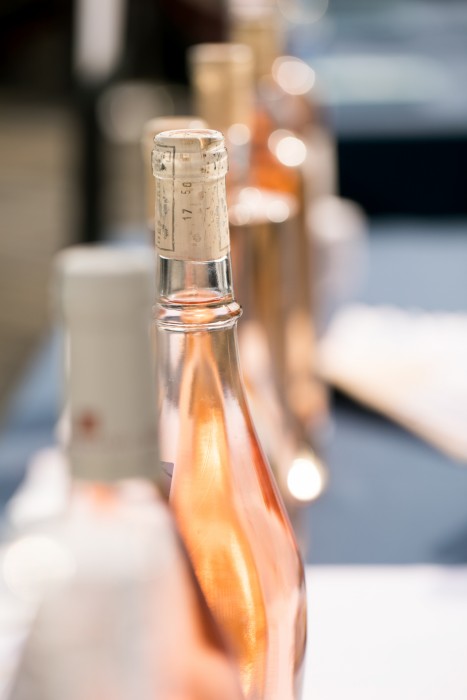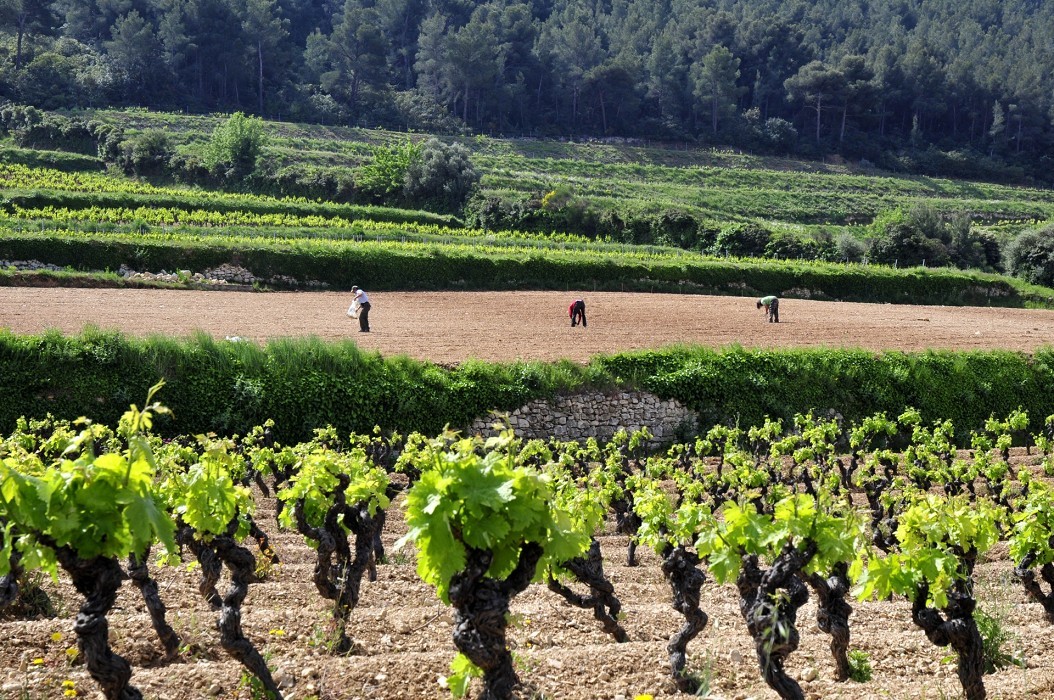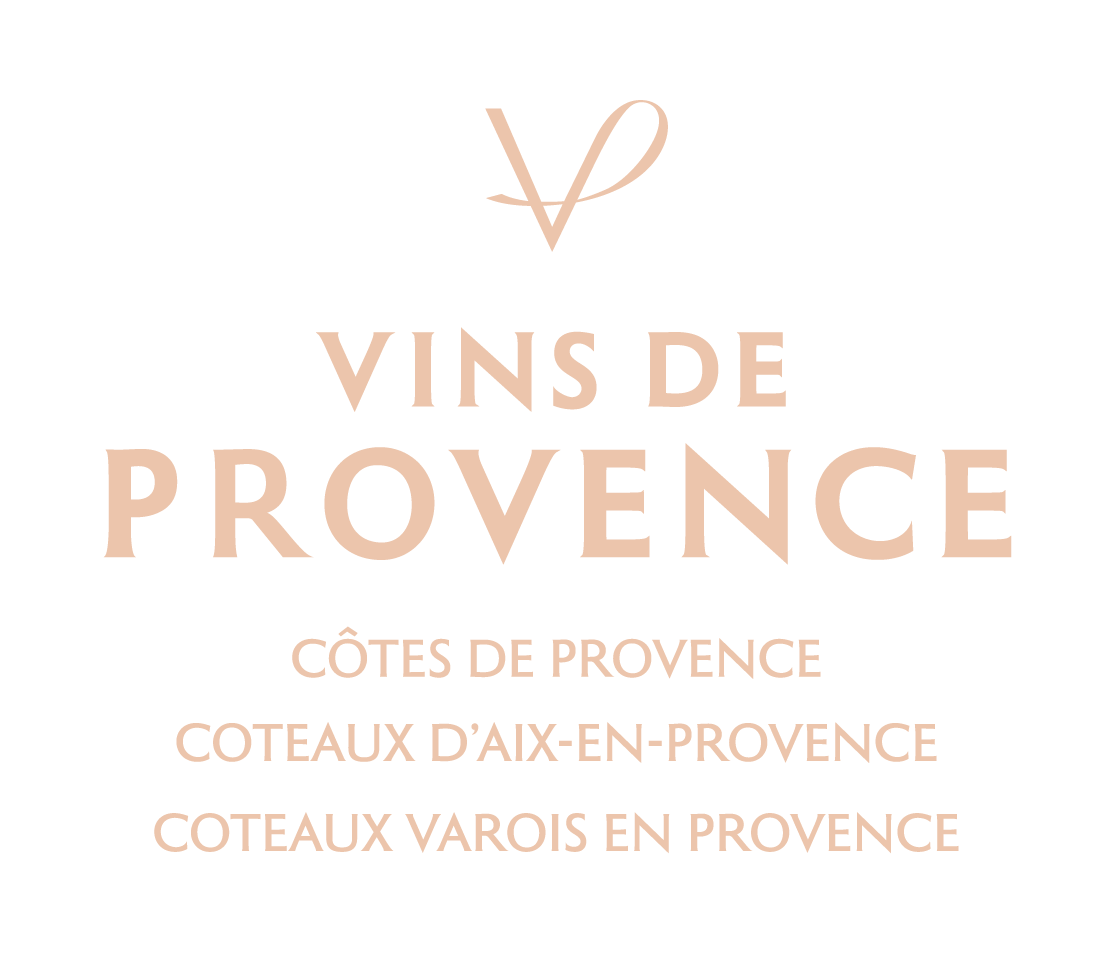Farming and Cellar Organization
Changes Happening Now and Peeking Over the Horizon
Though in use for thousands of years, vineyards are still in evolution today. Recently, the viticulture community has become more mindful of the ecological and human impacts of farming techniques and ideologies and have made strides to work in more sustainable ways.
With climate change impacting farming and potentially the typical Provence rosé style, many measures are under study as individual producers and research centers, like the Centre de Recherche et d’Expérimentation sur le Vin Rosé (Rosé Research Center) in Vidauban, Provence, prepare not only their vineyards, but also their cellars, for a hotter and drier planet.
Over the last century, average temperatures in the region increased 1.4C / 2.52F. The rate of temperature change is surging, and in just the next 80 years, Provence expects to see higher temperatures, between an additional 2-6C / 3.6-10.8F.
Provence is focused on short-, mid- and long-terms solutions to climate change. This is important because of the lead times required for certain elements of vineyard (especially) as well as cellar management. Staying ahead of the curve is critical for Provence to keep its position as, arguably, the world’s highest quality and most famous rosé producing region.

Vineyard Management
Vineyard management in the face of climate change can begin with simple techniques, starting with earlier pruning dates to finish with earlier harvest dates. In theory, it’s a good idea. However, Juliet Girard of the Syndicat des Vins Côtes de Provence states that studies to date only show about one week of difference for earlier versus later pruned vines. Further studies may show greater precision of possible techniques, but this is still out for discussion.
Moreover, given potential vine stress during the more challenging growing seasons, pruning more severely means the vine should ripen its clusters more quickly. A lower crop yield can, however, induce the undesired effect of producing faster ripening grapes with excess alcohol and color potential.
Throughout the season, careful canopy management can provide shade to grape clusters, especially on the western and southern sides of the vine. Well-exposed leaf surfaces bring another benefit: improved water efficiency. Furthermore, as harvest approaches, working with the canopy can reduce ripening. Provençal producers have seen that leaf pulling can slow ripening by six to eight days, with some varieties like Syrah being more effected than others. Gilles Masson, head of the Rosé Research Center, has launched recently a project called Vitirosé. Its aim is to examine how vine growth can be better adapted in the face of climate change, including tailoring canopy management specifically to compliment rosé production.
Sowing cover crops can help to maintain moisture in the soil, especially if they are not turned over. For the cover crops to not compete too fiercely for precious water resources, they must be thoughtfully managed by mowing or planting only every other or every third row. According to Pierre Duffort of Domaine de Rimauresq, cover crops alone help combat three major issues linked to climate change:
Higher air temperatures, especially in summer
- Once the cover crop is mowed at the beginning of the summer, it reduces direct sunshine impact on the soil as well as water evaporation. The isolation effect of the mowed cover crops is as much as 8-12 C/14-21 F, an enormous protective measure.
- Irregular precipitation events with violent thunderstorms
- Given the ferociousness of today’s thunderstorms, cover crops help prevent soil erosion thanks to the vast array of vine roots holding down soil. Additionally, for producers like Domaine de Rimauresq who cultivate organically, they are able to treat immediately for oïdium/powdery mildew and peronospora/downy mildew. This is because the organic matter on the surface not only allows vineyard machinery to pass through wet soils but also because it helps lessen the soil compaction of heavy machinery.
Less annual rain accumulation
- As cover crops dry out on the surface, their roots below ground dry out, too. This shrinkage leaves more pathways for water to infiltrate the soil. Post-storm, the cover crop retains humidity against the soil for several days.
Additionally, as Juliet Girard of the Syndicat des Vins de Provence points out, cover crops like clover and vetch work to engrain nitrogen in the soil, which works like a vitamin to the benefit of the plant.
Furthermore, Girard mentions that keeping undergrowth alive at the ends of rows where tractors turn is another step for Provence to take as well as eliminating chemical herbicides entirely.
Last and certainly not least, the use of irrigation has changed and likely will continue to evolve, despite certain producers who are devoutly against it philosophically. Only ten years ago, irrigation was forbidden in Provence. INAO (the Institut National des Appellations d’Origine et de la Qualité), the governing body that dictates what is and is not allowed in all aspects of AOP wine production, has greatly loosened these restrictions. Vignerons can now irrigate (where water is available) from June 15th through harvest (with a different set of (lower) yields for those that do irrigate. The next challenge is to optimize irrigation delivery. While drip irrigation has become widely used, underground irrigation provides even greater efficiency. This is key to having a very measured impact on nearby groundwater as well as the newly extended Canal de Provence.

New Vineyards
Planting new vineyards, while a more medium- to long-term project, could entail not only using different grape varieties and rootstocks but also using different sites. Cooler, north-facing and higher elevation sites that were once considered “at risk” for potential lack of ripeness are becoming more and more prized. Granted, all such considerations are not necessarily possible today given AOP laws, where specific terroir definitions prevail.
Another possibility for replanting vineyards is changing the orientation of the rows for trellised vines. Whereas rows with a north-south orientation have one side of the fruit zone facing the burning western sun and rows oriented east-west have one side baking in southern rays, rows oriented northwest-southeast or northeast-southwest can give vines a break from the hottest angles of sunshine.
Vineyard configurations can also be changed through planting density. While a high planting density has traditionally been favored to promote vine “stress” to result in more characterful fruit, climate change could encourage the reduction of vine density to mitigate hydric stress. Moreover, this can be implemented in new plantations as well as existing vineyards, the latter simply by removing existing vines.
Harvest Timing and Dates
Timing
The harvest dates is critical in deciding quality and style.
While acidity and alcohol are easy to test for, balancing these factors with flavor and phenol (both color and tannins) development are more of an art form. One way producers try to have the best of both worlds is the timing as well as the dates for their picking.
Over the last 15-20 years, wineries have begun picking during cooler hours. In fact, many wineries using mechanical harvesters to pick in the dark, at 2-3 am. More and more, even hand-harvesting is being carried out at night with the use of head lamps and portable stadium lighting. Cooler fruit has fresher acidity and a brighter aromatic profile.
Dates
Another way to preserve acidity and freshness is to harvest at an earlier date.
The catch is making certain that the grapes have achieved full flavor ripeness. Between rising temperatures and increasing water stress, vines can shut down and stop ripening until the ambient conditions are more favorable. (Laurence Berlemont of the Cabinet d’Agronomie Provençal estimates that there will be 37 more days of hydric stress between 2020-2050 as there were from 1970-2000 and 53 more days between 2070-2100 versus 1970-2000.)
This can cause uneven or less-than-desirable ripeness when harvest dates are rushed. Additionally, very hot temperatures rapidly reduce acidity. So, the possibility of lower acidity and unripe grapes can be a two-pronged result. This is particularly problematic for Grenache, which has naturally low acidity and tends to oxidize quickly. Hence, extra care must be devoted to harvesting Grenache on optimal dates.
Future Solutions
Mindful of the need to preserve its iconic rosés, the Provençal wine industry is working to stay ahead of predicted climate change occurences. Seeing every step of the growing cycle and production process as an opportunity for improvement, Provence hopes to avoid cataclysmic change in their vines and wines. As a Burgundian producer who also makes wine in Provence said after the torrid 2018 harvest, “This is our phylloxera.” That may true in a region that makes with single variety wines (Chardonnay and Pinot Noir, the latter especially delicate) hailing from largely similar soils with limited expositions. However, Provence has a far more varied palette of possibilities that should serve it well.
Cellar Management
Energy
Energy is one of the two critical elements of the Provençal cellar under scrutiny for years now.
Winemaking is a voracious energy consumer. With ever increasing energy costs further complicated by energy production and use causing CO2 emission, environmentally friendly practices are important not only for the world’s climate but also for consumers’ wallets.
Making Provence rosé wine is a particular energy hungry process because in order to maximize freshness and prevent oxidation, every stage of the winemaking, aging, bottling, storing and shipping process requires temperature control. Even harvesting requires more energy today as picking is largely mechanized and now often carried out under portable lighting booms at night.
Working to economize energy use by maximizing natural advantages - such as building cellars underground or into hillsides - has long been underway in Provence. Additionally, producers are investing to harness renewable resources like solar and wind power.
However, simply rethinking energy use can be easier and lead to immediately lowered energy usage. Two possible ways are incorporating more natural light into production facilities and using gravity flow to do the work of pumps and fork lifts.
Water
Winemaking also requires vast quantities of clean water.
Fresh water resources are becoming scarcer while hydric stress in the vineyards ramps up, taking greater tolls on vines as well as the people tending them. The extension of the Canal de Provence will provide more producers with improved water access while closely monitoring allowances so as to respect the region’s overall environmental. The use of micro-irrigation with other water conservation and water recycling efforts are anticipated to reduce strain on this important resource.
Interestingly, a new project from local scientific and environmental organization Ecoscience Provence combines energy and water savings through the reuse of wine bottles. Rather than recycling by destroying wine bottles to create new ones, La Consigne de Provence has created a consignment system of returning bottles to be washed and reused. Reusing bottles takes four times less energy and uses 33% less water.
References:
Berlemont, Laurence - Cabinet d’Agronomie Provençal
Duffort, Pierre - Domaine de Rimauresq
Ecoscience Provence, La Consigne de Provence
Girard, Juliet - Syndicat des Côtes de Provence
Ollat, Nathalie; Masson, Gilles; de la Fuente, Mario - Quels Rosés Pour Demain, Rencontres Internationales du Rosé
